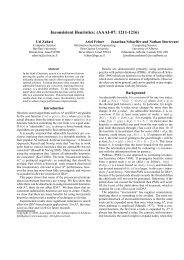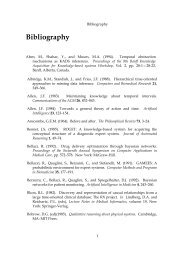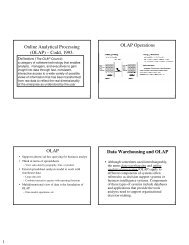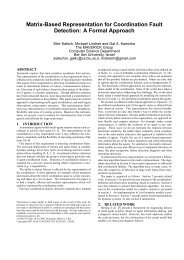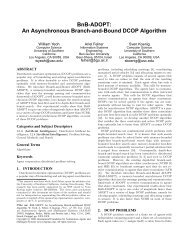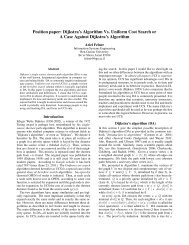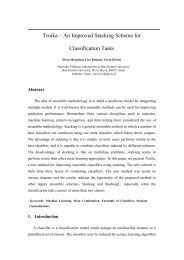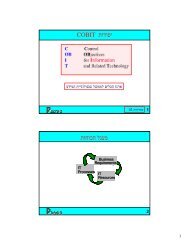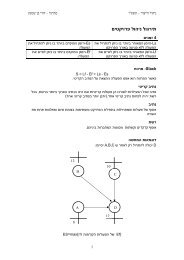The MP-MIX algorithm: Dynamic Search Strategy Selection in Multi ...
The MP-MIX algorithm: Dynamic Search Strategy Selection in Multi ...
The MP-MIX algorithm: Dynamic Search Strategy Selection in Multi ...
You also want an ePaper? Increase the reach of your titles
YUMPU automatically turns print PDFs into web optimized ePapers that Google loves.
2<br />
pr<strong>in</strong>ciple. Thus, a player us<strong>in</strong>g the <strong>MP</strong>-Mix <strong>algorithm</strong> will be<br />
able to change his search strategy dynamically as the game<br />
develops. To evaluate the <strong>algorithm</strong> we implemented the <strong>MP</strong>-<br />
Mix <strong>algorithm</strong> on 3 s<strong>in</strong>gle-w<strong>in</strong>ner and multi-player doma<strong>in</strong>s:<br />
1) Hearts — an imperfect-<strong>in</strong>formation, determ<strong>in</strong>istic game.<br />
2) Risk — a perfect-<strong>in</strong>formation, non-determ<strong>in</strong>istic game.<br />
3) Quoridor — a perfect-<strong>in</strong>formation, determ<strong>in</strong>istic game.<br />
Our experimental results show that <strong>in</strong> all doma<strong>in</strong>s, the <strong>MP</strong>-<br />
Mix approach significantly outperforms the other approaches<br />
<strong>in</strong> various sett<strong>in</strong>gs, and its w<strong>in</strong>n<strong>in</strong>g rate is higher. However,<br />
while the performance of <strong>MP</strong>-Mix was significantly better <strong>in</strong><br />
Risk and Quoridor, the results for Hearts were less impressive.<br />
In order to expla<strong>in</strong> the different behavior of <strong>MP</strong>-Mix we<br />
<strong>in</strong>troduce the opponent impact (OI). <strong>The</strong> opponent impact<br />
is a game specific property that describes the impact of<br />
moves decisions of a s<strong>in</strong>gle player on the performance of<br />
other players. In some games, the possibilities to impede<br />
the opponents’ are limited. Extreme examples are the multiplayer<br />
games of B<strong>in</strong>go and Yahtzee. In other games, such<br />
as Go Fish, the possibilities to impede the opponent almost<br />
always exist. We show how OI can be used to predict whether<br />
dynamically switch<strong>in</strong>g the search strategies and us<strong>in</strong>g the <strong>MP</strong>-<br />
Mix <strong>algorithm</strong> are beneficial. Our results suggest a positive<br />
correlation between the improvement of the <strong>MP</strong>-Mix approach<br />
over previous approaches and games with high OI.<br />
<strong>The</strong> structure of the paper is as follows: Section II provides<br />
the required background on the relevant search techniques. In<br />
section III we present the newly suggested directed offensive<br />
search strategy and the <strong>MP</strong>-Mix <strong>algorithm</strong>. <strong>The</strong> follow<strong>in</strong>g<br />
section IV presents our experimental results <strong>in</strong> three doma<strong>in</strong>s.<br />
<strong>The</strong> opponent impact is <strong>in</strong>troduced and discussed <strong>in</strong> section<br />
V. We conclude <strong>in</strong> section VI and present some ideas for<br />
future research <strong>in</strong> section VII. This paper extends a prelim<strong>in</strong>ary<br />
version that appeared <strong>in</strong> [19] by present<strong>in</strong>g experimental<br />
results <strong>in</strong> the Quoridor doma<strong>in</strong>, new experimental <strong>in</strong>sights<br />
on the behavior of <strong>MP</strong>-Mix, new theoretical properties and<br />
extend<strong>in</strong>g the discussions <strong>in</strong> all other sections.<br />
II. BACKGROUND<br />
When a player needs to select an action, he spans a search<br />
tree where nodes correspond to states of the game, edges<br />
correspond to moves and the root of the tree corresponds to<br />
the current location. We refer to this player as the root player.<br />
<strong>The</strong> leaves of the tree are evaluated accord<strong>in</strong>g to a heuristic<br />
static evaluation function (will be shortened to evaluation<br />
function from now on) and the values are propagated up to the<br />
root. Each level of the tree corresponds to a different player<br />
and each move corresponds to the player associated with the<br />
outgo<strong>in</strong>g level. Usually, given n players the evaluation function<br />
gives n values, each of them measures the merit of one of<br />
the n players. <strong>The</strong> root player chooses a move towards the<br />
leaf whose value was propagated all the way up to the root<br />
(usually denoted the pr<strong>in</strong>cipal leaf). When propagat<strong>in</strong>g values,<br />
the common assumption is that the opponents will use the<br />
same evaluation function as the root player (unless us<strong>in</strong>g some<br />
form of specific opponent model<strong>in</strong>g based <strong>algorithm</strong> such as<br />
the ones found <strong>in</strong> [1], [17]).<br />
Fig. 1.<br />
(1,4,5)<br />
(d)<br />
(6,4,0)<br />
(a) (b) (c)<br />
2 (3,5,2) 2 (6,4,0) 2<br />
1<br />
3 3 3 3 3 3<br />
(1,4,5) (6,3,1) (6,4,0) (3,5,2) (6,4,0) (1,4,5)<br />
3-player MaxN game tree<br />
In sequential, two-player zero-sum games (where players<br />
alternate turns), one evaluation value is enough assum<strong>in</strong>g one<br />
player aims to maximize this value while the other player aims<br />
to m<strong>in</strong>imize it. <strong>The</strong> evaluation value is usually the difference<br />
between the merits of the Max player to the merit of the M<strong>in</strong><br />
player. Values from the leaves are propagated accord<strong>in</strong>g to<br />
the well-known M<strong>in</strong>imax pr<strong>in</strong>ciple [18]. That is, assum<strong>in</strong>g the<br />
root player is a maximizer, <strong>in</strong> even (odd) levels, the maximum<br />
(m<strong>in</strong>imum) evaluation value among the children is propagated.<br />
Sequential, turn-based, multi-player games with n > 2<br />
players are more complicated. <strong>The</strong> assumption is that for<br />
each node the evaluation function returns a vector H of n<br />
evaluation values where h i estimates the merit of player i. Two<br />
basic approaches were suggested to generalize the M<strong>in</strong>imax<br />
pr<strong>in</strong>ciple to this case: MaxN [9] and Paranoid [16].<br />
A. MaxN<br />
<strong>The</strong> straightforward and classic generalization of the twoplayer<br />
M<strong>in</strong>imax <strong>algorithm</strong> to the multi-player case is the<br />
MaxN <strong>algorithm</strong> [9]. It assumes that each player will try to<br />
maximize his own evaluation value (<strong>in</strong> the evaluation vector),<br />
while disregard<strong>in</strong>g the values of other players. M<strong>in</strong>imax can<br />
be seen as a special case of MaxN, for n = 2. Figure 1<br />
(taken from [14]) presents an example of a 3-player search<br />
tree, alongside the evaluation vector at each level while<br />
activat<strong>in</strong>g the MaxN <strong>algorithm</strong>. <strong>The</strong> numbers <strong>in</strong>side the nodes<br />
correspond to the player of that level. <strong>The</strong> evaluation vector is<br />
presented below each node. Observe that the evaluation vectors<br />
<strong>in</strong> the second level were chosen by tak<strong>in</strong>g the maximum<br />
of the second component while the root player chooses the<br />
vector which maximizes his own evaluation value (the first<br />
component). In this example, the root player will eventually<br />
select the rightmost move that will resolve <strong>in</strong> node c as he has<br />
the highest evaluation value (=6) for the root player.<br />
B. Paranoid<br />
A different approach called the Paranoid approach, was<br />
first mentioned by Von Neuman and Morgenstern <strong>in</strong> [18], and<br />
was later analyzed and explored by Sturtevant <strong>in</strong> [16]. In this<br />
approach the root player takes a paranoid assumption that the<br />
opponent players will work <strong>in</strong> a coalition aga<strong>in</strong>st him and



